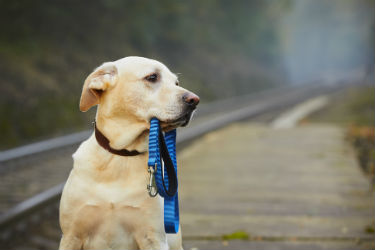Veterinarian Tips: Finding a Lost Pet

When a client comes to your practice with a flyer for a missing pet, you can help them by informing them of pet behavior. When clients are aware of the way a pet behaves when it is lost, the path to being reunited with their animal may be shortened!
Missing Pet Partnership
In an effort to increase the chances of reuniting a lost pet with their family, the national nonprofit organization, Missing Pet Partnership (MPP), has focused efforts on understanding the patterns of behavior of companion pets that have become lost. Using information gathered from physical searches and lost pet consultations, MPP has developed a program designed to be used in the search for lost animals. In addition, MPP has a program that can be used by shelter workers as a tool for helping pet owners find their lost pets.
Behaviors of a Lost Pet
When in their home, most animals are alert, playful, and have a friendly personality because they are comfortable in their environment. However, when an animal is lost, their behavior changes. The patterns observed when in their home no longer exist. In fact, the behavior of a lost animal is so different, oftentimes, their human family members are unable to find them even when they are close by.
The following information identifies specific patterns of behavior observed to occur in lost companion animals.
Cats
When a cat who spends time outside turns up missing, it often means that something disrupted their behavior of returning home
Cats become displaced when they are lost in unfamiliar territory. Their behavior is often to hide in fear nearby. When displaced, these cats may hide for a few days before returning home, or they will continue to hide. One method to recover a displaced cat is to use wildlife cameras to track their whereabouts and then to use baited humane traps.
Cats that are sick, injured or panicked will hide in areas where they are concealed. These animals will not meow, as noise could give up their location to a predator.
Dogs
Friendly but lost dogs often happily approach people when called. These dogs are often picked up close to their home. Because they are so friendly, their rescuer often ends up keeping them, sometimes without checking for an owner.
Dogs that are aloof and wary will try to avoid people. Once they overcome their fear or when their hunger takes control, they will accept human contact. By the time these dogs are recovered, they have lost weight, been injured, and their coat is ungroomed, giving them the appearance that they are stray and homeless.
Timid and skittish dogs seem to travel farther than others and are at a higher risk of being struck by a car. These dogs act fearful and often cower, which gives them the appearance of being abused. Rescuers that feel an animal has been abused often choose not to search for the animal’s true owner. Catching timid or skittish dogs is often done by using snares or baited humane traps.
When many dogs get lost, they travel. Often moving in a radius of 1 to 5 miles from where they became lost, a pet can travel a great distance in a short period of time. Unfortunately, this means a lost pet may quickly end up in a location that is far from the area being searched.
When clients are searching for their pet, remind them about this lost animal behavior: Dogs run and cats hide!
Preventing Lost Pets
Although advising clients to microchip their pets does not mean they’ll never be lost, the pet is more likely to be identified and returned home.
For more information on pet behaviors, contact your Covetrus representative at: 855.724.3461.
Sources:
Careers
Are you looking for a place to let your talents shine? At Covetrus, we help our practitioner customers better serve their patients and take pride in providing the best customer experience possible. Search our open positions to see our available opportunities.
Newsletter
Stay current with what’s going on with Covetrus, subscribe to receive our newsletter and email communications. Subscribers will receive the latest information in practice management, sales and marketing, animal health, and more.


Leave a comment